HOW TO FIND VERTICAL ASYMPTOTE OF COTANGENT FUNCTION
Subscribe to our ▶️ YouTube channel 🔴 for the latest videos, updates, and tips.
Subscribe to our ▶️ YouTube channel 🔴 for the latest videos, updates, and tips.
We use the characteristics of the cotangent curve to graph tangent functions of the form y = A cot (Bx- C), where B > 0
Step 1 :
Find two consecutive asymptotes by finding an interval containing one period.
A pair of consecutive asymptotes occurs at
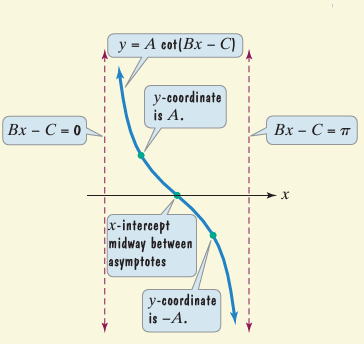
Step 2 :
cot x = cos x / sin x
Here sin x = k𝜋
In the given function, by equation BX - C to k𝜋 and applying the value of k, we can get more asymptotes.
Problem 1 :
Graph y = 3 cot 2x
Solution :
- A = 3, B = 2
- period = 𝜋/|B|
- period for the function y = 3 cot 2x is (0, 𝜋/2)
Step 1 :
Find two consecutive asymptotes, we do this by finding an interval containing one period.
An interval containing one period is (0, 𝜋/2). Thus two consecutive asymptotes occur at x = 0 and x = 𝜋/2.
Step 2 :
Vertical asymptote of y = cot x is k𝜋, where k is integer. Here
2x = k𝜋
x = k𝜋/2
- When k = -1, x = -𝜋/2
- When k = 0, x = 0
- When k = 1, x = 𝜋/2
- When k = 2, x = 𝜋
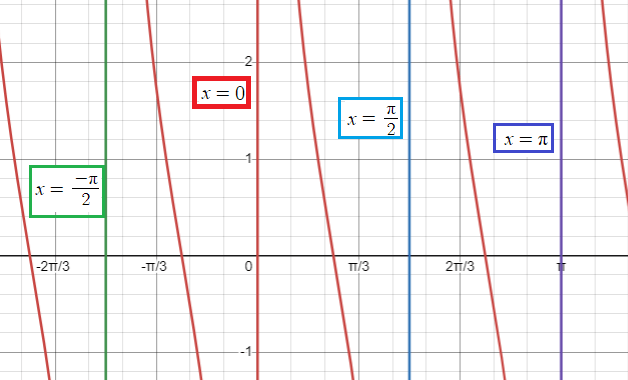
Problem 2 :
Graph y = (1/2) cot 2x
Solution :
- A = 1/2, B = 2
- period = 𝜋/|B|
- period for the function y = (1/2) cot 2x is (0, 𝜋/2)
Step 1 :
Find two consecutive asymptotes, we do this by finding an interval containing one period.
An interval containing one period is (0, 𝜋/2). Thus two consecutive asymptotes occur at x = 0 and x = 𝜋/2.
Step 2 :
Vertical asymptote of y = cot x is k𝜋, where k is integer. Here
2x = k𝜋
x = k𝜋/2
- When k = -1, x = -𝜋/2
- When k = 0, x = 0
- When k = 1, x = 𝜋/2
- When k = 2, x = 𝜋
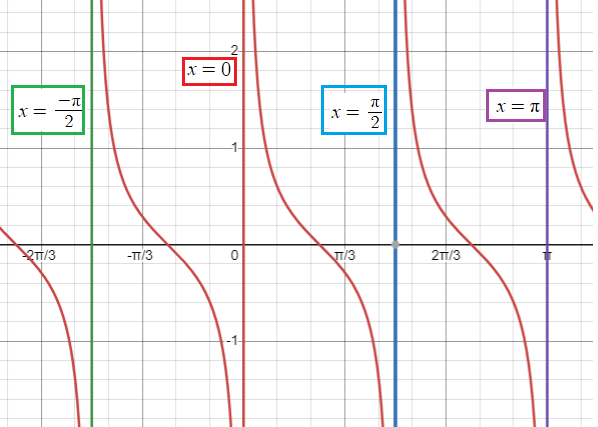
Problem 3 :
Graph y = -3 cot (𝜋/2)x
Solution :
- A = 3, B = 1/2
- period = 𝜋/|B|
- period for the function y = -3 cot (𝜋/2)x is (0, 2)
Step 1 :
Find two consecutive asymptotes, we do this by finding an interval containing one period.
An interval containing one period is (0, 2). Thus two consecutive asymptotes occur at x = 0 and x = 2.
Step 2 :
Vertical asymptote of y = cot x is k𝜋, where k is integer. Here
(𝜋/2)x = k𝜋
x = k𝜋/(𝜋/2)
x = 2k
- When k = -1, x = -2
- When k = 0, x = 0
- When k = 1, x = 2
- When k = 2, x = 4
Repeat the same pattern in the interval.
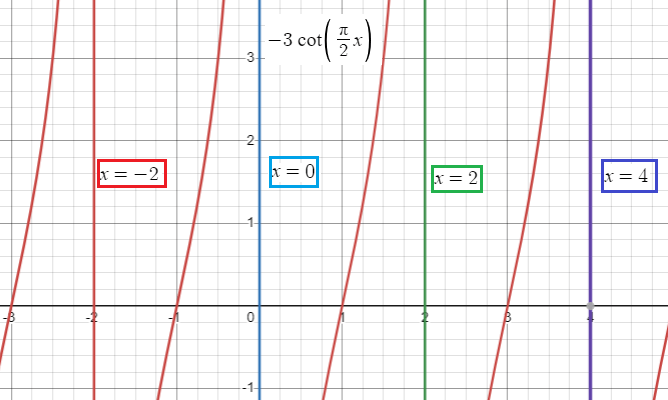
Problem 4 :
Graph y = 3 cot (x + 𝜋/2)
Solution :
- A = 3, B = 1
- period = 𝜋/|B| == > 𝜋
- period for the function y = 3 cot (x + 𝜋/2) is (0, 𝜋)
Step 1 :
Find two consecutive asymptotes, we do this by finding an interval containing one period.
An interval containing one period is (-𝜋/2, 𝜋/2). Thus two consecutive asymptotes occur at x = -𝜋/2 and x = 𝜋/2.
Step 2 :
Vertical asymptote of y = cot x is k𝜋, where k is integer. Here
x+𝜋/2 = k𝜋
x = k𝜋 - (𝜋/2)
x = (2k𝜋 - 𝜋)/2
x = (𝜋/2)(2k-1)
- When k = 0, x = -𝜋/2
- When k = 1, x = 𝜋/2
- When k = 2, x = 3𝜋/2
Repeat the same pattern in the interval.
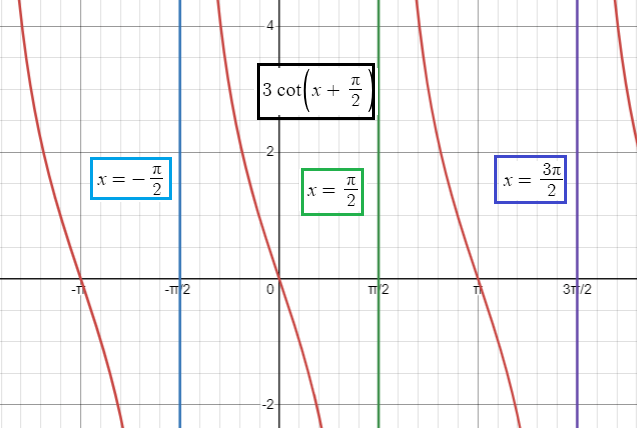
Problem 5 :
Graph y = 3 cot (x + 𝜋/4)
Solution :
- A = 3, B = 1
- period = 𝜋/|B| == > 𝜋
- period for the function y = 3 cot (x + 𝜋/4) is (0, 𝜋)
Step 1 :
Find two consecutive asymptotes, we do this by finding an interval containing one period.
An interval containing one period is (-𝜋/4, 3𝜋/4). Thus two consecutive asymptotes occur at x = -𝜋/4 and x = 3𝜋/4.
Step 2 :
Vertical asymptote of y = cot x is k𝜋, where k is integer. Here
(x + 𝜋/4)= k𝜋
x = k𝜋 - (𝜋/4)
x = (4k𝜋 - 𝜋)/4
x = (𝜋/4)(4k-1)
- When k = 0, x = -𝜋/4
- When k = 1, x = 3𝜋/4
- When k = 2, x = 7𝜋/4
Repeat the same pattern in the interval.
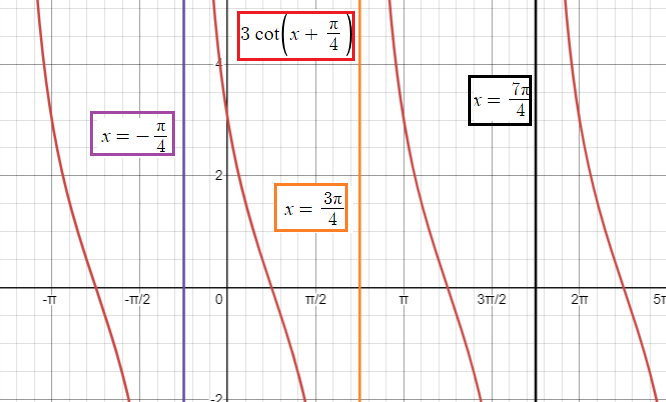
Problem 6 :
In order to graph y = 3 cot (𝜋/2) x, an interval containing one period is found by solving 0 < (𝜋/2)x < 𝜋.
An interval containing one period is two consecutive asymptotes occur at x = and x = .
Solution :
- A = 3, B = 𝜋/2
- period = 𝜋/|B| == > 2
- period for the function y = y = 3 cot (𝜋/2) x is (0, 2)
An interval containing one period is (0, 2). Thus two consecutive asymptotes occur at x = 0 and x = 2.
Vertical asymptote of y = cot x is k𝜋, where k is integer. Here
(𝜋/2)x = k𝜋
x = k𝜋 x (2/𝜋)
x = 2k
- When k = 0, x = 0
- When k = 1, x = 2
- When k = 2, x = 4
Recent Articles
-
Finding Range of Values Inequality Problems
May 21, 24 08:51 PM
Finding Range of Values Inequality Problems -
Solving Two Step Inequality Word Problems
May 21, 24 08:51 AM
Solving Two Step Inequality Word Problems -
Exponential Function Context and Data Modeling
May 20, 24 10:45 PM
Exponential Function Context and Data Modeling